U.S. housing market slowing sharply
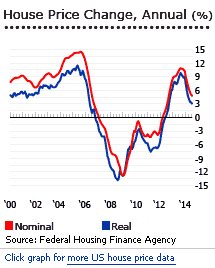 The U.S. housing market is evidently cooling again, despite higher-than-expected economic growth during the latest quarter. Housing demand and construction activity are both slowing sharply.
The U.S. housing market is evidently cooling again, despite higher-than-expected economic growth during the latest quarter. Housing demand and construction activity are both slowing sharply.
There is a somewhat contradictory situation with secondary home price rises slowing, but primary prices continuing to rise strongly.
During the year to Q3 2014, the S&P/Case-Shiller seasonally-adjusted national home price index rose by 4.81% (3.08% inflation-adjusted), the lowest annual increase since Q3 2012, based on the latest figures released by Standard & Poor’s. Quarter-on-quarter, the national home price index increased by just 0.68% (0.77% inflation-adjusted) in Q3 2014. The national slowdown in prices is confirmed by Federal Housing Finance Agency (FHFA)´s seasonally-adjusted purchase-only U.S. house price index, which rose by just 4.58% (2.76% inflation-adjusted) y-o-y in Q3 2014, the lowest annual increase in the past eight quarters. The index increased 1.02% (0.84% inflation-adjusted) q-o-q during the latest quarter.
Despite this, primary housing market prices continue to surge. In October 2014, the median sales price of new homes sold in the U.S. rose by 15.4% to US$305,000 on the same period last year, according to the U.S. Census Bureau.
Yet demand is slowing sharply. New house sales increased by just 1.8% in October 2014 from the same period last year, according to the U.S. Census Bureau. About 55% of these transactions were in the South.
First-time homebuyers are delaying their purchases. Recently, the share of homes bought by first-time buyers dropped to 33% from 38% in 2013 and the lowest level since 1987, based on figures released by the U.S. National Association of Realtors. Moreover, about one-third of adults in the country are now living with relatives or roommates, as compared to just 27.4% in 2006, according to real estate firm, Zillow.
Despite this, U.S. home builder sentiment rose in November 2014 to 58, up from 54 in the previous month, according to the National Association of Home Builders. A reading of 50 is the midpoint between positive and negative sentiment. New privately-owned housing unit starts rose by 7.8% y-o-y during the year to October 2014, according to the U.S. Census Bureau, while housing completions rose by 8.1% y-o-y - both sharp slowdowns from the double-digit rises in previous periods.
The slowdown in U.S. housing market price rises is expected to continue in 2015, bolstering home sales to first-time buyers.
Three forecasts for prices:
- Annual home price growth is projected at below 5% by September 2015, according to CoreLogic.
- U.S. home values are expected to increase by an average of 4.8% in 2014 from a year earlier, and by another 3.7% in 2015, according to the Zillow Home Price Expectations Survey.
- Barclays projects U.S. home prices to increase by about 5% this year, 3% in 2015 and by another 2% in 2016.
U.S. economic growth in Q3 2014 surpassed expectations, at 3.9%, after growth of 4.2% in Q2 2014 and an annual decline of 2.1% in Q1 2014. The U.S. economy is expected to expand by 2.2% this year and by another 3.1% in 2015, according to the IMF.
Local house price variations
Despite the overall housing market slowdown, most of the U.S.´s 20 major cities saw strong house price rises, with Miami registering the biggest y-o-y increase of 10.3% in Q3 2014, followed by Las Vegas (9.1%), San Francisco (7.9%), Dallas (7.4%), Portland (6.7%), Denver (6.2%), and Seattle (6%).
During the U.S. housing boom (1996-Q1 2006), all 20 main U.S. cities experienced spectacular house price rises. Los Angeles registered the biggest house price rise of 268.1%, followed by San Diego (250.1%), San Francisco (227.8%), and Miami (214.6%).
In Q2 2006, house prices started to fall. From Q2 2006 to Q4 2011, the S&P/Case-Shiller composite-10 home price index plunged 34%. Of the ten largest U.S. metro areas, Phoenix registered the biggest drop (down 55.5%), followed by Detroit (-44.4%), San Francisco (-41%), Los Angeles (-40.6%), and San Diego (-39.9%).
Starting the second half of 2012, the U.S. housing market started to show strong recovery. Phoenix led the housing recovery. In 2012, Phoenix house prices rose by 23% from a year earlier, followed by Detroit (15.1%), San Francisco (14.4%), Las Vegas (12.9%), and Minneapolis (12.1%). All of the 20 largest cities in the U.S., except New York, saw house price rises in 2012 from a year earlier. The U.S. housing market grew stronger in 2013, with Las Vegas registering the biggest annual house price increase of 25.6%, followed by San Francisco (22.7%) and Los Angeles (20.7%).
HOUSE PRICE CHANGE (%) |
US CITIES | (y-o-y) |
(y-o-y) |
(y-o-y) |
|
| New York | |||||
| Los Angeles | |||||
| Chicago | |||||
| Phoenix | |||||
| San Diego | |||||
| Dallas | |||||
| San Francisco | |||||
| Detroit | |||||
| Boston | |||||
| Seattle | |||||
| Composite-10 | |||||
| Composite-20 | |||||
| Source: S&P | |||||
During the year to September 2014, the Pacific region registered the biggest house price increase of 7.1%, followed by the Mountain region (5.8%) and the West South Central (5.8%), based on figures from the FHFA. Other regions with modest to minimal annual house price increases included East North Central with house prices rising by 4.3% y-o-y in September 2014, South Pacific (3.9%), West North Central (2.9%), East South Central (1.9%), Middle Atlantic (1.7%) and New England (1.7%).
Demand slowing sharply
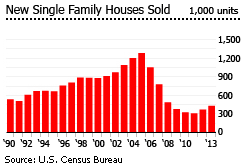
The number of houses sold (seasonally-adjusted) in the U.S. in October 2014 rose by just 1.8% from a year earlier, to 458,000 units, according to the U.S. Census Bureau. About 55% of these transactions were in the South. All, except the West, registered annual declines in housing demand in October 2014. The number of houses sold dropped by 6.3% in the Northeast, by 4.5% in the South and declined by 2.9% in the Midwest.
Total existing-home sales, including single family and condo units, were down 3.8% y-o-y in Q3 2014.
Growth in residential construction slowing, despite better homebuilder sentiment

Privately-owned housing units authorized by building permits in October 2014 rose by only 1.2% y-o-y, to a seasonally adjusted annual rate of 1,080,000 units, according to the U.S. Census Bureau. Likewise, new privately-owned housing unit starts rose by 7.8% y-o-y during the year to October 2014, according to the U.S. Census Bureau, while housing completions rose by 8.1% y-o-y.
These were a sharp slowdown from double-digit rises seen in the previous periods.
From 1990 to 2007, the total number of housing starts averaged 1.5 million units per year. However due to the global crisis, housing starts fell to 1.1 million units in 2008, 794,400 units in 2009, 651,700 units in 2010 and 584,900 units in 2011.
"Residential construction [has been] held back by a large inventory of foreclosed and distressed properties and by tight credit conditions for construction loans and mortgages," said Stanley Fisher, deputy chairman at the Federal Reserve.
The total number of existing homes available for sale in the country stood at 2.3 million units in Q3 2014, up by 6% from a year earlier. Over the same period, the average supply was 5.4 months, up from 5 months in Q3 2013.
Delinquency rate and foreclosures continue to fall
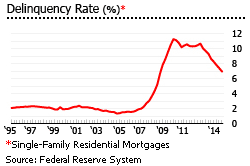
In the third quarter of 2014, the delinquency rate on single-family residential mortgages fell to 6.98%, the lowest rate since Q4 2008, based on figures from the U.S. Fed.
Likewise distressed homes, which consists of foreclosures and short sales sold at discounted prices, accounted for 9% of total sales in Q3 2014, down from 14% in the previous year.
“Distressed sales are becoming less prevalent in many parts of the country and will likely be in the low single-digits percentagewise at this time next year,” said Lawrence Yun, chief economist at the National Association of Realtors.
However, five of the nation’s 20 largest metro areas posted year-over-year increases in foreclosure activity. These included New York (up 71%), Houston (up 70%), Philadelphia (up 43%), Boston (up 27%) and Baltimore (up 22%).
“There are hotspots in some of the inland areas but overall we are seeing foreclosure activity continue to decline to historical norms," said Chris Pollinger of First Team Real Estate.
Interest rates remain low
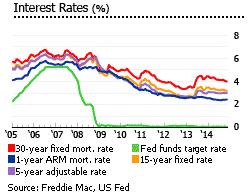
The U.S. Fed’s key rate remained unchanged at 0.09% in November 2014, having been cut in December 2008. The rate can hardly fall further - indeed, is soon expected to rise.
The fed funds rate peaked at 5.25% in August 2007.
Cheaper mortgages continue to fuel housing demand. The average interest rate for 30-year fixed rate mortgages (FRMs) fell to 4% in November 2014 from 4.26% a year earlier, based on figures released by Freddie Mac. Likewise, the average rate for 15-year FRMs dropped to 3.19% from 3.3% over the same period.
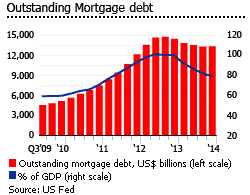
The average interest rate for 1-year adjustable rate mortgages (ARMs) fell to a 2.44% in November 2014 from 2.61% a year earlier, according to Freddie Mac. On the other hand, the average interest rate for 5-year adjustable rate mortgages increased slightly to 3% from 2.97% over the same period.
Despite lower rates, the U.S. mortgage market has been shrinking. In 2013, the size of the mortgage market was equivalent to 79.3% of GDP, down from 82.2% of GDP in a year earlier and from more than 100% of GDP in 2009, based on figures released by the U.S. Federal Reserve System.
In the second quarter of 2014, the total outstanding mortgage debt in the U.S. increased by a meagre 0.7% y-o-y to US$13.32 trillion, according to the U.S. Fed.
Homeownership rate falling
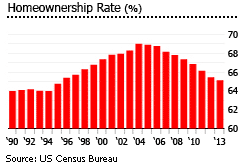
Homeownership rate in the U.S. has been falling for almost a decade now, as rising property prices and tight credit standards held back demand.
In 2013, the country’s homeownership rate stood at an average of 65.1%, down from 65.5% in the previous year and from its peak level of 69% in 2004, based on figures from the U.S. Census Bureau.
In the third quarter of 2014, the homw ownership rate dropped to 64.3%.
Rents rising modestly, vacancy rate falling
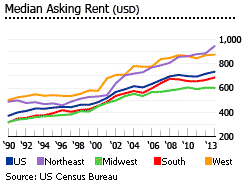
The median asking rent rose by 2.7% to US$756 per month in the third quarter of 2014, from the same period last year, according to the U.S. Census Bureau.
However, this conceals local variations in rental rates:
- In the Midwest, the median asking rent surged by 11% to US$638 per month in Q3 2014 from a year earlier.
- In the South, the median asking rent rose by 6.2% y-o-y to US$738 per month over the same period.
- In the West, the median asking rent dropped 1.8% during the year to Q3 2014, to US$860 per month.
- In the Northeast, the median asking rent fell by 7.6% to US$893 in Q3 2014 from a year earlier.
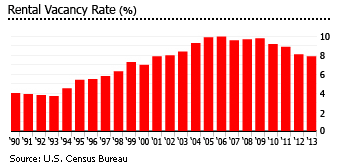
The nationwide rental vacancy rate stood at 7.4% in the third quarter of 2014, down from 7.5% in the previous quarter and 8.3% in the same period last year, according to the U.S. Census Bureau. Regionally, the Northeast had the lowest rental vacancy rate of 5.3% in Q3 2014, followed by the West (5.5%), and the Midwest (8.5%). The South had the highest rental vacancy rate of 9.2% in Q3 2014.
Rents rising faster than house prices
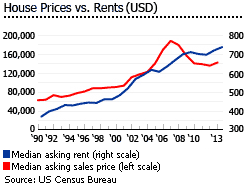
The house price-to-rent ratio has been falling since 2008. From 2008 to 2013, house prices fell deeply, while median rents were more or less static, according to the U.S. Census Bureau.
A falling price-to-rent ratio is a signal that the housing market has good potential for recovery, in the long term.
Unemployment at six-year low, wages rising again

In November 2014, the overall unemployment rate in the U.S. remained at 5.8%, a post-recession low point. The U.S. economy added 321,000 jobs in November 2014. For the first eleven months, the country has added about 2.65 million jobs, an average of around 241,000 jobs every month.
“The labor market is healing faster than almost any analysts expected just a few months ago,” said Scott Anderson of the Bank of the West.
The country’s unemployment rate averaged 5% from 1998 to 2008. However due to the global economic and financial meltdown, the jobless rate surged to 9.3% in 2009 and to 9.6% in 2010. The unemployment rate gradually dropped to 8.9% in 2011, 8.1% in 2012, and 7.4% in 2013, according to the IMF.
In November 2014, average monthly earnings increased 2.4% from the same period last year, to US$853.24.
“The coming months will tell us whether November was a fluke or the beginning of a sustained pickup from the 2 percent annual wage gains we’ve had over the past four years,” said Guy Berger of RBS.
Robust economic growth, low inflation

The world’s largest economy is expected to grow by 2.2% this year and by another 3.1% in 2015, mainly due to strong domestic demand, supported by a reduction in the fiscal drag as a result of the recent budget agreement, according to the International Monetary Fund (IMF). The economy expanded by 1.9% in 2013, from growth rates of 2.8% in 2012, 1.8% in 2011, and 2.5% in 2010.
The federal government is no longer engaged in the harsh austerity that reduced growth in 2013 through tax hikes and spending cuts. In January 2014, the U.S. Congress halted the implementation of tens of billions in additional spending cuts that were supposedly be executed this year.
In November 2014, the U.S. federal budget deficit narrowed to US$56.8 billion, less than half the deficit recorded in a year earlier and narrower than analysts’ expectations of a US$72.5 billion deficit. The federal budget deficit was estimated to have narrowed to US$486 billion in 2014, down from US$680 billion in the previous year and the lowest level in seven years, according to the CBO. As a result, the shortfall is projected to drop from 10.1% of GDP in 2009 to about 2.76% of GDP for this year.
Inflation remains below the levels considered acceptable and healthy for the economy, and is projected at 1.9% this year, slightly below the Fed’s 2% target.. Low inflation has enabled the Fed to maintain its key rates at record low levels to stimulate consumer spending.